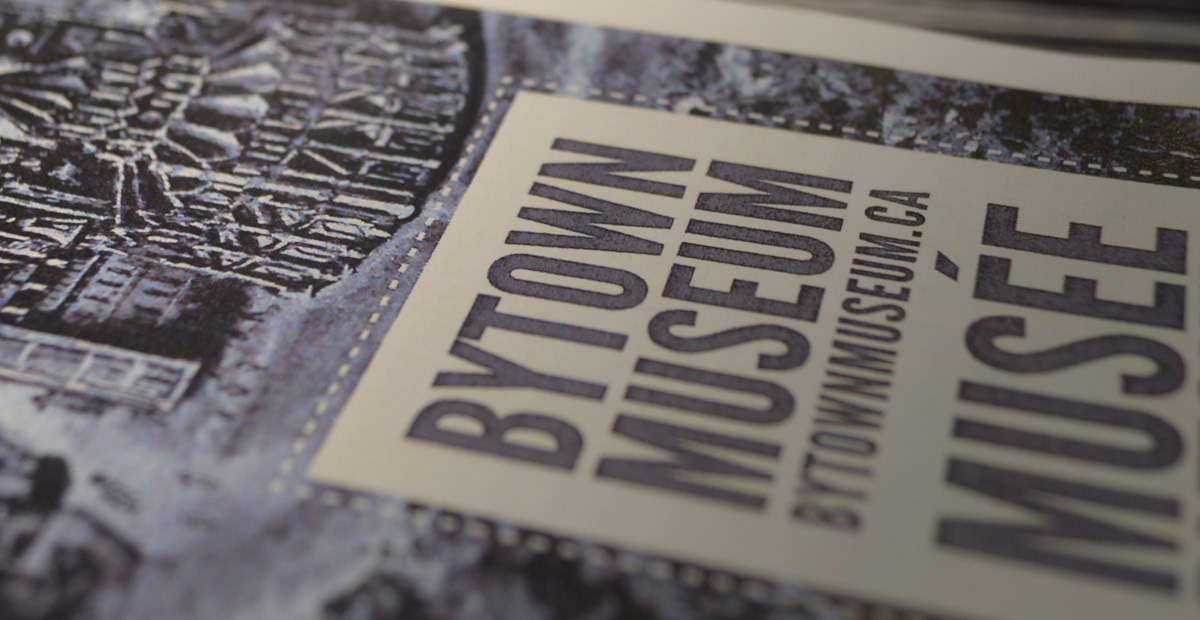The Central Canada Exhibition: Ottawa Fairs and their Importance of Showcasing Agricultural Success | Exposition du Canada central : Les foires d’Ottawa, témoins de la réussite agricole
By/par Emily M. (Youth Council Member/Membre du Conseil des Jeunes)
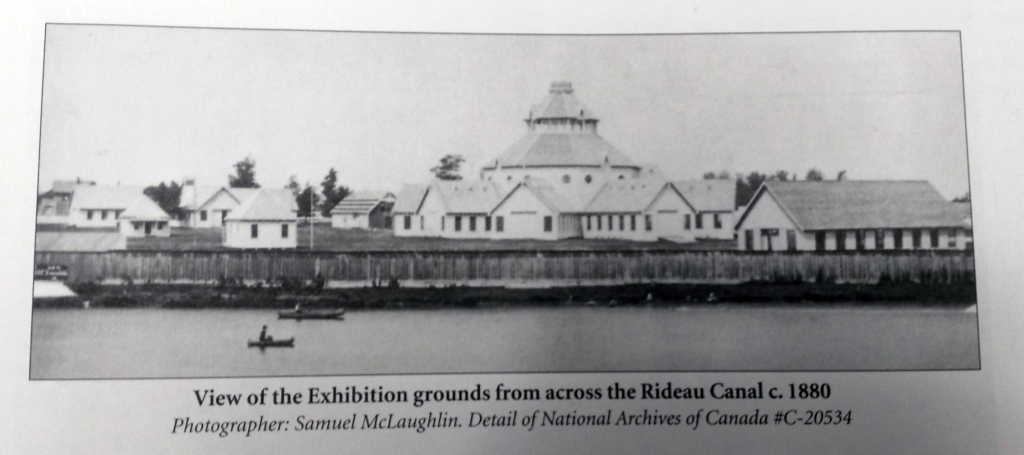
View of the Exhibition grounds from across the Rideau Canal c.1800 Source: An Ottawa Album: Glimpses of the Way We Were by Marion Van de Wetering
When Lansdowne comes to mind today, we think of the RedBlacks stadium, cinema, and the many restaurants and shops that have opened since 2014. Behind all the new development lies two older buildings, the Aberdeen Pavilion and Horticulture Building, which are remaining elements of Lansdowne’s past, as the previous site of the Central Canada Exhibition also known as the Ex.
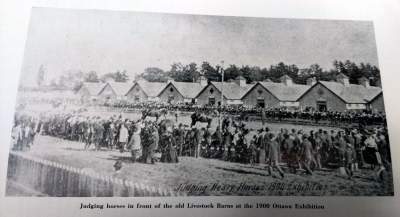
View of the Old Livestock Barns at 1900 Exhibition. Source: The Central Canada Exhibition Association through 65 years, 1888-1953 by The Central Canada Exhibition Association, 1954.
In 1868, The Central Canada Exhibition was established when the Ottawa Agricultural Society bought 19 acres of land east of Bank Street along the canal. Two years later on September 24th, 1888, the exhibition officially opened. Some of the exhibitions included in the Central Canada Exhibition were: 12 horse, 11 cattle, 8 sheep, and 5 poultry classes, along with agricultural and horticultural products, engines, machinery, and other miscellaneous manufacturers. There were also natural history specimens, textile fabrics, carriages, wood and various other homeworks by ladies, such as quilting. Prizes ranging from 30$ for 1st prize to 1$ for lower prizes, were given out to these classes with higher prizes being awarded to livestock. The exhibition also included midways, performances such as trapeze acts, horse races, chariot races, and other attractions.
Below is a timeline highlighting some of the key events that happened at the Central Canada Exhibition.
1888 – Admittance charge at the first exhibition grounds was 25 cents per person, for two horse vehicles the fee was 75 cents, and for one horse rigs 50 cents with the driver admitted free.
1898 – The Aberdeen Pavilion, named after Governor General Lord Aberdeen, opens.
1908 – The First Pure Food Show was staged by the Retail Grocers’ Association and held at Howick Hall with gate receipts being the largest in history.
1910 – The first general distribution of Marquis Wheat made from the Dominion Experimental Farms, developed by Dr. William Sanders, director of the Central Experimental Farms. Sanders developed this wheat that would mature in 90 days from the time of planting, which was ideal for prairie provinces.
1914 – The new Horticultural Hall was used for the first time with it being established by Martin Burrell, Dominion Minister of Agriculture.
1920-1930 – Farmers from outlying areas often used trains to transport their animals to the Ex. The animals were then loaded off at Dows Lake and brought to the grounds by children, who were paid 25c for each animal they brought in.
1931 – The Central Canada Exhibition Association established the Junior Farmers Department, where boys and girls from farms competed in various competitions such as the judging of seeds, livestock, weeds, and homemaking classes. It was the first time in Canada that a special department for farm boys and girls was created, which lead to 4-H clubs being established in the 1950’s.
1942-1946 – No exhibition was held at the Lansdowne Park due to the property being occupied by the Department of National Defence as an induction and training centre for the military.
1950 – The First International Day was to promote international goodwill and friendship.
1952 – The Directors gave a party for the agriculture and horticulture exhibitors as an expression of appreciation to their contributions towards the success of the exhibitions.
1974 – The Exhibition Association starts to work on moving the carnival to a new location in Ottawa.
2010 – The last year the Ex was held at Lansdowne Park after 122 years.
2014 – The Central Canada Exhibition Association (CCEA) dissolved its group, which ended the Ex.
The exhibition grounds drastically changed over the years, including new buildings being erected like the Horticulture Hall and others which were torn down. Below is a visual timeline of the architecture of the Central Canada Exhibition at Lansdowne Park from 1880 to 1955.
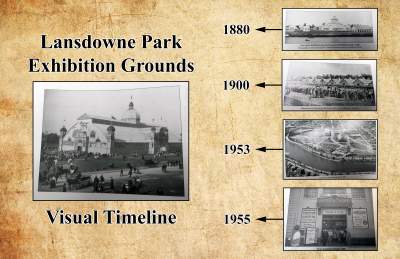
Exhibition Hall, Central Canada Fair, Lansdowne Par. Source: Ottawa. From A Fair Share: A History of Agricultural Societies and Fairs in Ontario 1792-1992 by Ontario Association of Agricultural Societies, 1992. Image on the top right: View of the Exhibition grounds from across the Rideau Canal c.1800. Source: photograph by Samuel McLaughlin, Detail of National Archives of Canada #C-20534 from An Ottawa Album: Glimpses of the Way We Were by Marion Van de Wetering. Second image from the top right: Judging Horses in front of the old Livestock Barns at the 1900 Ottawa Exhibition, Source: The Central Canada Exhibition Association through 65 years, 1888-1953 by The Central Canada Exhibition Association, 1954. Third image from the top right: Lansdowne Park from the Air in 1953 Source: photograph by Spartan Air Services found in The Central Canada Exhibition Association through 65 years, 1888-1953 by The Central Canada Exhibition Association, 1954. Bottom image on the right: The Ex grandstand entrance, 1955 Source: photograph from City of Ottawa Archives, Andrews-Newton Collection found in the Central Canada Exhibition at Lansdowne 1888-2002 Souvenir Program, by the Central Canada Exhibition Association, 2002.
Throughout the years the exhibition had a particular emphasis on the improvement of raising livestock and advancement of agricultural quality. An example is the Marquis Wheat, a hard spring wheat that would mature in 90 days, which was developed in Ottawa by Dr. William Sanders, Director of the Central Experimental Farms, along with his son Charles Sanders. Although this particular breed today can only grow in certain areas due to the disease ‘Wheat Steam Rust’, it continues to be the principal parent of the best bread wheat varieties today.
For farmers, the exhibition was also an important place to advertise their livestock and agricultural products. For instance in the article, Celebrating 114 Years of the Ex at Lansdowne Park!, Ms. Joyce Macgregor, a member of the Central Canada Exhibition Board, reminisces on her experiences at the Ex, commenting on the fact that it was a big money maker for her father; “It was a form of advertising,” and “If people liked what they saw, they would buy your breeding stock and dairy cattle.”
Furthermore, the annual exhibition contributed immensely to the economic, educational, and social progress of Ottawa and Eastern Ontario as well as Western Quebec through promoting the improvement of livestock production and agriculture. It resulted in progress within the industry as well as commerce, the arts and sciences. In addition, it became the principal social rendezvous of the year in Ottawa providing the finest in entertainment, music and dance.
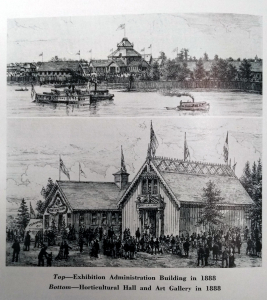
Exhibition Administrative Building, Horticultural Hall and Art Gallery. Source: The Central Canada Exhibition Association through 65 years, 1888-1953 by The Central Canada Exhibition Association, 1954.
Unfortunately Lansdowne Park was unable to support the growing Exhibition. The Central Canada Exhibition Association (CCEA) bought a site on Albion Road, however the land was not serviced and it would have cost roughly $25 million to make it workable. In 2014, the CCEA then met and decided to dissolve the group and the Ex was finished.
Alongside the Ex, Ottawa organized another fair called the Eastern Ontario Livestock and Poultry Show in 1902. This show was designed to mimic the success of the Royal Winter Fair in Toronto and bring agricultural communities in Eastern Ontario and Quebec together. The first show was housed in a building on Canal Street owned by the Ottawa Forwarding Company. In 1905, The Central Exhibition held the second show at Lansdowne. Like the Ex, there were classes for poultry (the main exhibit), sheep, swine, and all breeds of cattle. The Musical Ride of the Royal Canadian Horse Artillery from Kingston also participated in the fair. Much like the Ex, the Ottawa Winter Fair in 1992, was cancelled due to problems with facilities.
Both the Ex and the Eastern Ontario Livestock and Poultry Show were important venues for agricultural exhibitors from all over Canada and even the US.
Today the Carp Fair started by the Huntley Agricultural Society in 1855, is one of the only fairs close enough to Ottawa’s core. Although in Ottawa’s core there is very little remaining of the Ex besides the Aberdeen Pavilion and Horticulture Hall, Ottawa should be remembered as a historical agricultural hub.
Next fall, I encourage everyone to travel to the outskirts of Ottawa to attend the Carp Fair to witness a tradition that has occurred in the Ottawa area since the mid –1800s.
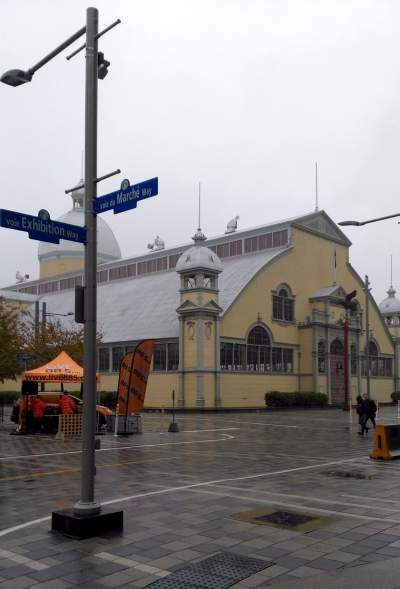
View of the Aberdeen Pavilion today located on Exhibition Way.Source: photo taken by Emily McKay on November 2nd, 2018.
Bibliography
“Vote by central ex board means official end of Ottawa Tradition,” Ottawa Sun. 2015/12/20.https://ottawasun.com/2015/12/20/vote-by-central-ex-board-means-official-end-of-an-ottawa-tradition/wcm/4d348e29-fc91-4b0c-bf64-cde9b7464e2b
Central Canada Exhibition at Lansdowne 1888-2002 Souvenir Program, Central Canada Exhibition Association, 2002.
A History of Agricultural Societies and Fairs in Ontario 1792-1992, Ontario Association of Agricultural Societies, 1992.
The Central Canada Exhibition Association through 65 years, 1888-1953, Central Canada Exhibition Association, 1954.
Van de Wetering, Marion. An Ottawa Album: Glimpses of the Way We Were. Toronto: Dundurn Press, 1997.
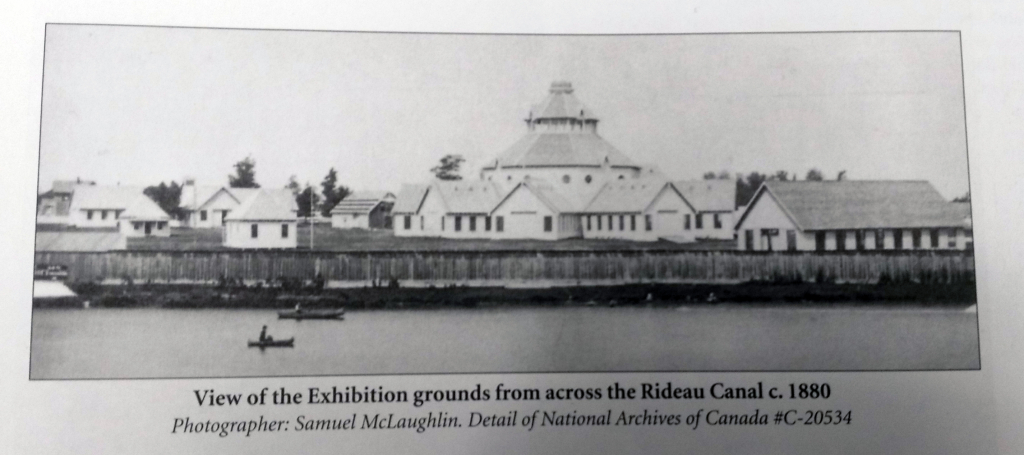
Le site de l’exposition vu depuis la rive opposée du canal Rideau, vers 1800. Source : An Ottawa Album: Glimpses of the Way We Were par Marion Van de Wetering
Aujourd’hui, le parc Lansdowne évoque le stade du Rouge et Noir, le cinéma et les multiples boutiques et restaurants ouverts depuis 2014. Derrière ce nouvel aménagement se trouvent deux bâtiments plus anciens, le pavillon Aberdeen et l’édifice de l’horticulture, vestiges de Lansdowne qui témoignent que l’endroit a accueilli l’Exposition du Canada central, aussi appelée la Super Ex.
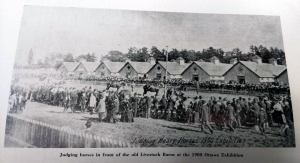
Évaluation des chevaux devant les anciennes granges à bétail, Exposition de 1900 à Ottawa. Source : The Central Canada Exhibition Association through 65 years, 1888-1953, publié par l’Association de l’Exposition du Canada central, 1954.
L’Exposition du Canada central est fondée en 1886, quand l’Ottawa Agricultural Society achète un terrain de 19 acres à l’est de la rue Bank, le long du canal. L’exposition ouvre officiellement deux ans plus tard, le 24 septembre 1888; on peut entre autres y voir 12 chevaux, 11 bovins, 8 moutons et 5 espèces de volaille ainsi que de la machinerie, des engins et autres produits agricoles et horticoles. L’Exposition présente aussi des spécimens d’histoire naturelle, des tissus, des chariots, du bois et des travaux d’aiguille réalisés par des femmes, comme des courtepointes. Les éléments montrés à l’Exposition peuvent recevoir des prix variant de trente dollars (premier prix) à un dollar, les plus hauts prix étant attribués au bétail. Les visiteurs bénéficient également d’attractions, de spectacles donnés notamment par des acrobates, de courses de chevaux et autres divertissements.
Chronologie des principaux événements qui ont ponctué l’histoire de l’Exposition du Canada central :
1888 – Le prix d’entrée à la première exposition est fixé à 25 cents par personne, à 75 cents pour les véhicules à deux chevaux et à 50 cents pour ceux tirés par un cheval, et le conducteur est admis gratuitement.
1898 – Ouverture du pavillon Aberdeen, nommé ainsi en l’honneur du gouverneur général lord Aberdeen.
1908 – La Retail Grocers’ Association organise au Howick Hall le premier festival de nourriture sattvique (Pure Food Show). Les recettes à l’entrée atteignent un montant record.
1910 – Première distribution générale de blé Marquis, cultivé à la ferme expérimentale du dominion par William Sanders, directeur de la Ferme expérimentale centrale. Sanders a mis au point ce blé, qui mûrit en 90 jours à partir de la date de plantation et s’avère idéal pour les Prairies.
1914 – On utilise pour la première fois le nouveau bâtiment horticole fondé par Martin Burrell, ministre de l’Agriculture du dominion.
1920-1930 – Les fermiers des régions environnantes transportent souvent leurs bêtes par train jusqu’à la Super Ex. Les animaux sont alors déchargés près du lac Dows. De là, des enfants les conduisent sur les lieux de l’exposition, recevant 25 ¢ par animal déplacé.
1931 – L’Exposition du Canada central crée un ministère des jeunes fermiers, grâce auquel garçons et filles des fermes se livrent à divers concours tels que l’évaluation des graines, du bétail et des mauvaises herbes et participent à des classes d’activités ménagères. C’est la première fois qu’un ministère canadien est consacré à des garçons et à des filles de ferme, et cela conduit à la création, dans les années 1950, de cercles 4‑H.
1942-1946 – On ne présente aucune exposition au parc Lansdowne car le ministère de la Défense nationale a fait de ce terrain son centre d’accueil et d’entraînement militaire.
1950 – On instaure la première Journée internationale pour promouvoir la bonne volonté et l’amitié internationales.
1952 – Les directeurs organisent une fête pour les exposants agricoles et horticoles afin de les remercier d’avoir contribué à la réussite des expositions.
1974 – L’Association de l’Exposition commence à déplacer la foire vers un nouveau lieu à Ottawa.
2010 – Dernière année où la Super Ex se tient au parc Lansdowne, après 122 ans.
2014 – L’Association de l’Exposition du Canada central est dissoute, ce qui met fin à la Super Ex.
Le site de l’Exposition se transforme au fil des années. Entre autres, on construit de nouveaux édifices comme le bâtiment horticole, et d’autres sont détruits. La chronologie visuelle qui suit illustre l’architecture de l’Exposition du Canada central au parc Lansdowne de 1880 à 1955.
Translation for the visual timeline below:
Lansdowne Park = Parc Lansdowne / Exhibition Grounds = Site de l’Exposition / Visual Timeline = Chronologie visuelle

Bâtiment de l’Exposition, Exposition du Canada central, parc Lansdowne. Source : A Fair Share: A History of Agricultural Societies and Fairs in Ontario 1792-1992, Ontario Association of Agricultural Societies, Ottawa, 1992. En haut à droite (1880) : Le site de l’Exposition vu depuis la rive opposée du canal Rideau, vers 1800. Source : An Ottawa Album: Glimpses of the Way We Were par Marion Van de Wetering, photographie de Samuel McLaughlin, détail de Bibliothèque et Archives Canada (#C-20534). 2e photo à droite (1900) : Évaluation des chevaux devant les anciennes granges à bétail, Exposition de 1900 à Ottawa. Source : The Central Canada Exhibition Association through 65 years, 1888-1953, publié par l’Association de l’Exposition du Canada central, 1954. 3e photo à droite (1953) : Vue aérienne du parc Lansdowne en 1953. Source : The Central Canada Exhibition Association through 65 years, 1888-1953, publié par l’Association de l’Exposition du Canada central, 1954. Photographie de Spartan Air Services. En bas à droite (1955) : Entrée du stade de la Super Ex, 1955. Source : Programme souvenir de l’Exposition du Canada central au parc Lansdowne, 1888-2002, publié par l’Association de l’Exposition du Canada central, 2002. Photographie tirée des Archives de la Ville d’Ottawa, Collection Andrews-Newton.
Au fil des ans, l’Exposition a privilégié l’amélioration des conditions d’élevage du bétail et de la qualité de l’agriculture. Le blé Marquis en donne un bel exemple : il s’agit d’un blé dur de printemps qui mûrit en 90 jours, mis au point à Ottawa par William Sanders, directeur de la Ferme expérimentale centrale, et par son fils Charles Sanders. Même si cette variété ne pousse aujourd’hui que dans certaines régions en raison de la maladie de la rouille du blé, elle demeure le principal parent des meilleures variétés de blé produites de nos jours.
L’Exposition a également servi de vitrine permettant aux fermiers d’annoncer leurs produits agricoles et leur bétail. Ainsi, dans l’article Celebrating 114 Years of the Ex at Lansdowne Park!, Joyce Macgregor, membre du conseil d’administration de l’Exposition du Canada central, se rappelle ses expériences à la Super Ex, soulignant que celle‑ci rapportait gros à son père : « C’était en quelque sorte de la publicité […] Si les visiteurs aimaient ce qu’ils voyaient, ils achetaient vos animaux reproducteurs et vos bovins laitiers. »
En outre, l’exposition annuelle a largement favorisé le progrès économique, éducatif et social d’Ottawa, de l’est de l’Ontario ainsi que de l’ouest du Québec, contribuant à faire connaître les améliorations apportées à l’élevage du bétail et à l’agriculture. Au résultat, l’industrie, le commerce, les arts et les sciences ont progressé. De plus, la Super Ex est devenue le principal rendez‑vous social de l’année à Ottawa, offrant de magnifiques divertissements et spectacles de danse et de musique.

Bâtiment administratif de l’exposition (photo du haut); et Bâtiment horticole et galerie d’art (photo du bas). Source : The Central Canada Exhibition Association through 65 years, 1888-1953, publié par l’Association de l’Exposition du Canada central, 1954.
Malheureusement, le parc Lansdowne ne pouvait plus accueillir l’Exposition lorsque celle-ci a pris de l’ampleur. L’Association de l’Exposition du Canada central (AECC) s’est procuré un terrain rue Albion, mais le site ne comprenait aucun service. Il aurait fallu dépenser 25 millions de dollars pour le réaménager. En 2014, les membres réunis de l’AECC ont dissout l’Association et mis fin à la Super Ex.
Parallèlement à la Super Ex, Ottawa organise en 1902 une autre foire, l’Eastern Ontario Livestock and Poultry Show, qui s’inspire du succès remporté par la Royal Winter Fair, à Toronto. La foire d’Ottawa vise à réunir les communautés agricoles de l’est de l’Ontario et celles du Québec. La première foire a lieu dans un bâtiment situé rue Canal, qui appartient à l’Ottawa Forwarding Company. En 1905, une seconde foire est tenue au parc Lansdowne. On y trouve, comme dans l’Exposition du Canada central, diverses espèces de volailles (présentation principale), des moutons, des porcs et toutes les races de bétail. Le Carrousel de la Royal Canadian Horse Artillery de Kingston y participe également. À l’instar de la Super Ex, la foire d’hiver d’Ottawa est dissoute en 1992 en raison de problèmes d’installation.
La Super Ex et l’Eastern Ontario Livestock and Poultry Show sont d’importantes manifestations agricoles qui offrent une vitrine aux exposants venus de tout le Canada et même des États-Unis.
La foire actuelle de Carp, créée en 1855 par la Huntley Agricultural Society, est l’une des rares foires tenues près du cœur d’Ottawa. Bien qu’il ne reste au centre de la ville que peu de traces de la Super Ex, sinon le pavillon Aberdeen et le bâtiment horticole, Ottawa a été un foyer agricole dont il faut se souvenir.
L’automne prochain, je vous encourage tous à visiter la foire de Carp, dans les environs d’Ottawa, afin d’y découvrir une tradition de la région présente depuis le milieu des années 1800.

Vue du pavillon Aberdeen aujourd’hui situé rue Exhibition Source : Photographie prise par Emily McKay le 2 nov. 2018
Bibliographie
« Vote by Central Ex board means official end of an Ottawa tradition », Ottawa Sun, 20 déc. 2015. https://ottawasun.com/2015/12/20/vote-by-central-ex-board-means-official-end-of-an-ottawa-tradition/wcm/4d348e29-fc91-4b0c-bf64-cde9b7464e2b
Central Canada Exhibition at Lansdowne 1888-2002 Souvenir Program, Association de l’Exposition du Canada central, 2002.
A History of Agricultural Societies and Fairs in Ontario 1792-1992, Ontario Association of Agricultural Societies, 1992.
The Central Canada Exhibition Association through 65 years, 1888-1953, Association de l’Exposition du Canada central, 1954.
Van de Wetering, Marion. An Ottawa Album: Glimpses of the Way We Were. Toronto, Dundurn Press, 1997.

